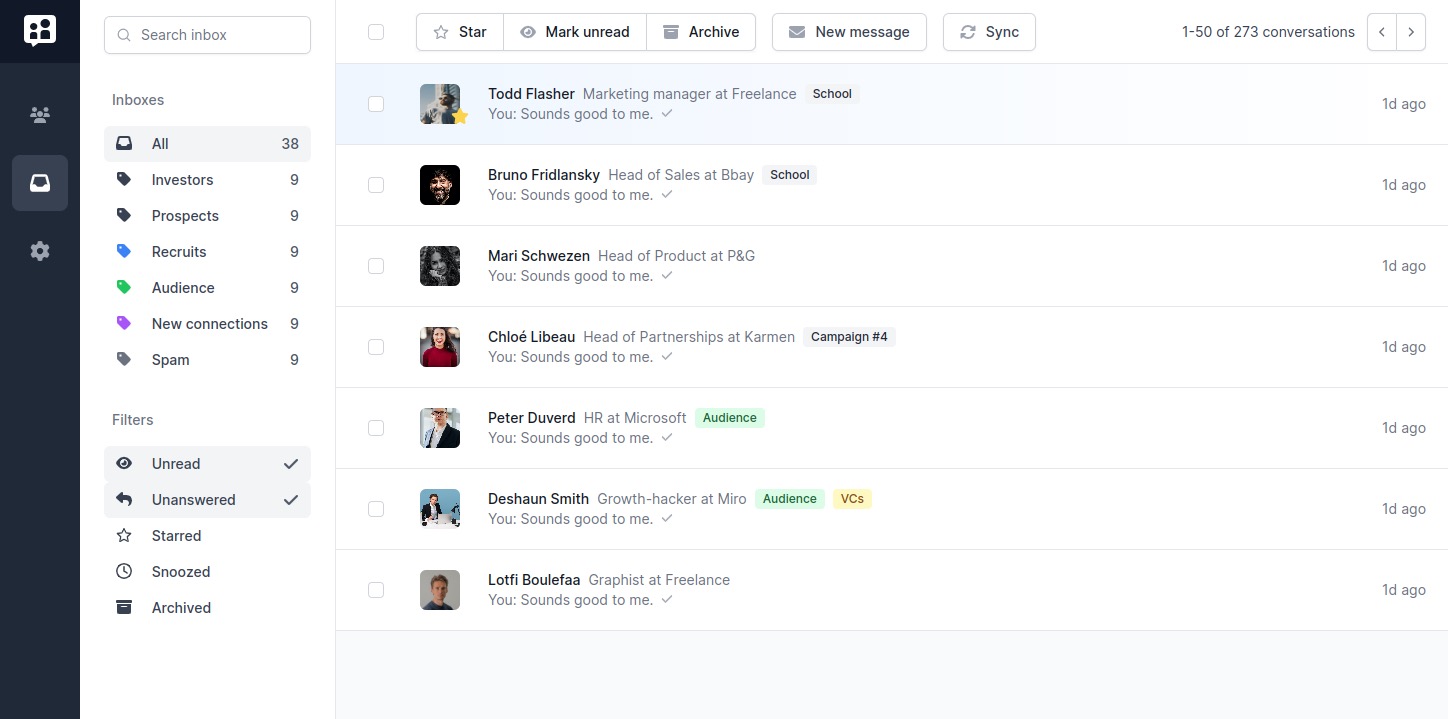Just because you've listened to music all your life doesn't mean you can play every instrument, right? By the same token, if you've never learned, you probably don't know how to properly manage emails.
Inbox Zero is a methodology meant to keep your inbox clean and your brain sane. They are tons of variants, but at Poked we like to keep things simple, so here is the Inbox Zero methodology summed up in one chart.
The Inbox Zero Chart

Unless you just needed a reminder, we recommend you keep reading the core concepts and details 4 D’s of inbox zero before implementing.
Inbox Zero 10 Core Concepts
To make Inbox Zero work, we need to unlearn some bad habits, and make some new ones.
1. Inbox Zero Doesn't Mean Zero Emails
The goal of Inbox Zero isn't to answer all your emails instantly. Instead, it's designed to help you sleep better at night by ensuring you handle important emails promptly.
2. Process Emails, Don't Just Answer Them
Managing emails requires work: searching for information, talking to someone, preparing a file, etc.
Every time you leave your inbox to complete one of these tasks, you risk losing focus, going off on a tangent, and potentially missing a far more important email.
With Inbox Zero, you process every email first, and deal with tasks that take longer than two minutes later.
3. Keep a to-do list close
For all these longer tasks that are generated by the emails that you can not answer to right now, use a to-do list. They are tons of ways to-do software around, find the one that fits you best.
Paper to-do list are absolutely OK if they work for you.
4. Turn Off Your Inbox
Keeping your inbox open constantly or having notifications pop up on your screen is a surefire recipe for stress.
Designate two specific times each day to process your emails. Embrace not responding for a few hours. This will lead to a healthier life for both you and your coworkers.
If you're worried that's not enough (trust us, it is), start with four times a day and gradually reduce.
5. Marking Emails as Unread is Broken
Many people mark emails as unread as a reminder of what they need to do. Here's why this approach is flawed:
- It's vague. Unread messages don't have an expiration date, leaving them in your inbox indefinitely.
- It's messy. Unread conversations clutter the inbox, making it difficult to spot important emails.
- It's confusing. Considering something you've read as unread is illogical.
- It's inconsistent. Marking emails as unread may not work consistently across devices or email clients.
The only reason to mark an email as unread is if you accidentally opened it.
6. Forget about folders
Folders are remnants from the Age of Paper. They were used to find things faster. Today we have the search bar, that finds information much faster than any folder system.
7. Centralize your email
Having to jump from one inbox to another, sometimes across email clients, is a terrible waste of your time.
Not, it isn’t fun to configure multiple emails, but once done, the sheer time saved by having done it will be worth it 100 fold.
The Inbox Zero Process
When you’re ready to take on a new batch of emails, your inbox is full of emails. The processing of your emails consist in the following.

Delegate
If you receive an email that would be someone an email is for someone else, you shall delegate it to the right person. Simply forward that email, eventually adding a note for whom it may concern.
Action: Forward this email to have it leave the inbox.
Do
Answer to the emails if and only if they can be answered to in under 2 minutes. For the
Action: Send it to clear your inbox.
Defer
For email that need an action on your part, loking up some info, prepping up a file, or anything over 2 minutes, mark it in your to-do list.
Action: Snooze that email for a later date.
Delete
For email that require no action on your part, but might be useful to have stored somewhere, archive them. If there’s no chance you’ll ever look for that email (newsletter, ads, notifications, etc.), simply deleted them.
Action: Archive (or delete)
Practical steps to setting start right now
How do you get started when you have a gazillion emails in your inbox? I’ve had to save a few soulds from their email inbox over the years, and here are some practical steps to get you started right away.
1. Archive Every Email Older Than a Month
Mass archiving old emails offers two significant advantages:
- It gets you started. Chances are, no email from 2017 is essential anymore.
- It's reversible. If you had an important bill in your inbox, it would still be available in your archive.
This step alone will remove 90% of emails in your inbox, and that's a massive win.
2. Sort Your Inbox by Oldest First and Start Processing
Time to put theory into practice. Go through each email and determine if you need to Do, Delegate, Defer, or Delete.
3. Unsubscribe from Everything Possible
If you're subscribed to useless newsletters or notifications, look for the unsubscribe button (usually at the bottom of the email) and opt-out. Gmail also offers a useful shortcut to unsubscribe from most automated emails. Use it!

4. Delete Unnecessary Notification Emails
Notification emails often create noise and mental fatigue, but we're so used to them that we don't notice. First, unsubscribe from them if you haven't already. Next, use your email client's search feature to filter emails by address or keyword. Once you're sure no important emails have slipped through the search, select all and delete them. You won't miss them!

5. Maintain Your Inbox Clean!
Now that you've achieved a clean inbox, make it a habit to process your emails regularly using the Inbox Zero techniques. This will help you stay organized and maintain your newfound inbox cleanliness.
FAQ Inbox Zero
Can Inbox Zero be applied to all emails ?
Yes, Inbox Zero can be adapted to work with any email client. As long as they have the basic Forward, Snooze, and Archive features. The core principles of Inbox Zero remain the same.
What about messaging platforms?
In theory, yes. But in practice, most messaging platforms are intended for personal use, and therefore have limited features allowing you to organize your inbox.
Are there popular variants to inbox zero?
Sure, there are several variations of the Inbox Zero concept. For example, the "Yesterbox" technique involves processing all emails from the previous day before moving on to new emails.
Another variation is the "Inbox 20" method, which allows for a small buffer of 20 emails in the inbox at any given time. If you’re feeling adventurous, you can also look for Inbox 1-2-3 or Inbox Today.
Inbox Zero is a flexible system, and you can should adapt it to your needs. Just one rule, though: Don’t never, ever use “mark unread” again 😉

